Expert Advice on Family Tents
tent buying guide

Tents come in many different shapes, sizes and styles. From one person designs made to fit in a rucksack, to eight berth frame tents ready to be fully furnished with everything including the kitchen sink! In between them there are numerous styles offering excellent head and elbowroom, made out of lightweight materials that are suitable for a variety of locations. It is important to choose the correct equipment for the purpose that you intend to use it. The advantages of camping are many. The initial outlay is relatively low and the ease that a tent can be transported gives freedom. There are various types of tents available each designed with a particular purpose in mind.
Firstly, you need to establish how the tent is to be carried, e.g. in a rucksack or by car. The details printed with each tent will state its weight, a very important consideration if you have to walk any distance. These details will also state the height in the living area and the sleeping area. It may be essential that you can stand in the living area but not in the sleeping area or it may be necessary for you to be able to stand where-ever you are within the tent. The smaller lighter weight tents do not provide for standing height but the headroom when sitting is very variable so care must be taken to choose the right height for your comfort.
Tents vary in size considerably. Consider how many people are to sleep in the tent. Do you require one large sleeping area or do you prefer separated sleeping compartments? The tents are usually labelled two person or three person etc. This is based on average size adults. Do check the actual measurements given to establish that you have adequate length and width to accommodate the people who are to use the tent. The living areas are shown with sizes marked. Consider what equipment i.e. tables and chairs, that you will wish to have within the tent and check that the sizes marked will in fact be adequate. Below are the different styles of tents available.
Frame Tents
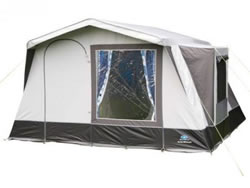
Frame tents give the best all round headroom and living space. They offer separate sleeping compartments, kitchen and living area. The frame is generally of steel. Flysheets are of cotton, though occasionally they are made of synthetic fabrics.
Ridge Tents
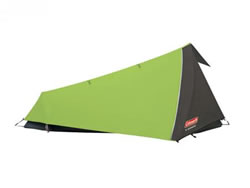
This is a triangular shaped tent. It has a horizontal pole supported by the two end vertical poles. These tents are very sturdy with plenty of headroom. Their weakness is the sides, which are unsupported. These tents are pitched end on to the wind, by the guy ropes.
Dome Tents
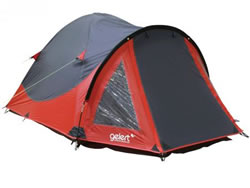
These tents are, as the name suggests, dome shaped. They are very simple to erect using lightweight flexible poles that thread through a sleeve in the tent fabric crossing at the top. The poles are of glass reinforced plastic or alloy. This type of tent, in the smaller size, is a great choice for the backpacker or motor biker and they range in size up to large enough to accommodate a family or large group. The dome of tent is our best selling family tent. They offer great value for money with their generous sizes, ease of erection and are easy to transport due to their relatively small pack size. Do remember that the higher the dome the more vulnerable they are in windy conditions.
Geodesic Tents
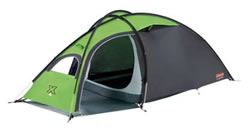
These tents are very similar to the dome tents except that they have a different pole configuration that gives more strength in windy conditions. The flexible poles cross at different levels and hold the fabric taut.
Touring Tents
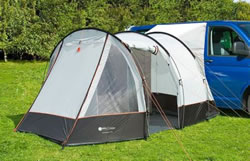
These include extended ridge and extended dome. These tents are usually a high ridge or dome with a good size porch area for shade, shelter or cooking. Please be aware that cooking is not recommended in any nylon or polyester tent and great care should be taken when using any appliance in a cotton frame tent. The tent may have windows. The poles are of steel, alloy or glass reinforced plastic. The usual fabric is nylon or polyester although a few are made in cotton.
Vis-a-vis Tents
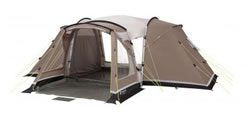
This term applies to tents with sleeping compartments on either side of a living area. The basic tent can be either ridge or dome style. Most are made in lightweight nylon or polyester A point worth remembering is that the higher the tent the more vulnerable it is in windy conditions.
Hoop Tents
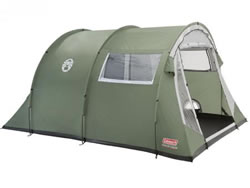
Hoop tents combine the best features of the ridge and dome tents in a single design. They are strong and offer plenty of room inside. They comprise of a single or multiple hoop- these being known as the tunnel tent. The single hoop is favoured by the backpacker because of its lightweight, size and strength. The tunnel tent has, usually, three hoops and an entrance at both ends. Mountaineers for their high wind resistance and lightness favour them.
What your tent is made of
Tents are made from a variety of different materials. The majority has a breathable inner sleeping section and a separate waterproof flysheet. This two-walled construction provides insulation and prevents the build up of condensation inside the tent.
Cotton is a natural fabric. It can be coated with PVC for the roof and the strip around the bottom, known as the skirt. Condensation can leave clothing and bedding feeling damp and wet. The use of cotton allows the tent fabric to breathe and so produce less condensation.
However cotton is heavier and bulkier when packed and so is generally used for frame tents where the weight is less important. Smaller, lightweight tents may use cotton as the inner sleeping compartment fabric. The disadvantage of cotton in tent manufacture is that it will rot if not maintained properly. However if proper care is taken they will last years. Nylon and polyester are used for the majority of dome, vis-a-vis and ridge tents. These fabrics are generally coated with one or more polyurethane coatings to provide waterproofing. This type of fabric has the advantage in that it dries quickly, is light in weight and will pack down to a small size. It also needs minimum maintenance. Nylon and polyester can become brittle and deteriorate over long time exposure to bright sunlight.
A Final Word
Camping is fun and if you choose the right tent, for the type of use you require and the right size to accommodate you and all you wish to take with you, you will enjoy many happy holidays in it. Most tent manufacturers will publish details on the construction of their tents and this guide will help you to decide which design is best suited to your needs. Remember to make sure you also have adequate pegs, a peg remover and a mallet! This will ensure a trouble free pitching of your chosen tent and all you have to do then is, relax and enjoy yourself.












